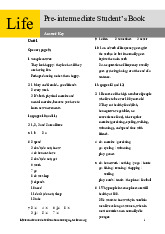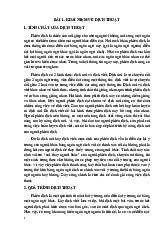





Preview text:
LESSON PLAN
TIẾNG ANH 11 FRIENDS GLOBAL UNIT 1: GENERATIONS
LESSON 1H- WRITING: A MESSAGE I. OBJECTIVES
By the end of this lesson, Ss will be able to: 1. Knowledge
- Write a message in response to an advertisement.
- Gain vocabulary to understand conversations between international penfriends. 2. Competences
- Develop communication skills and creativity.
- Be collaborative and supportive in pair work and teamwork.
- Actively join in class activities. 3. Personal qualities
- Understand and give polite requests. - Develop self-study skills. II. MATERIALS
- Grade 11 textbook, Unit 1, Writing
- Computer connected to the Internet
- Projector / TV/ pictures and cards
- Phần mềm tương tác sachso.vn Language analysis Form Pronunciation Meaning
the act of advertising something and making it 1. advertisement (n) /ədˈvɜːtɪsmənt/ public. 2. be into sth/ sb (phrase)
to be interested in something in an active way. 3. be mad about sth (phrase)
to be fond of someone or something. 4. refer to sth (phrase) /rɪˈfɜː(r)/
to mention or speak about somebody/something. Assumption
Anticipated difficulties Solutions
- Encourage students to work in pairs and in groups so
Students are reluctant to work in
that they can help each other. groups.
- Provide feedback and help if necessary.
- Explain expectations for each task in detail.
- Continue to explain task expectations in small
chunks (before every activity).
Students may lack vocabulary to deliver - Provide vocabulary and useful language before a speech assigning tasks
- Encourage students to work in groups so that they can help each other. III. PROCEDURES 1. WARM-UP (3 mins) a. Objectives:
- Introduce the new lesson and set the scene for Ss to acquire new language.
- Get students' attention at the beginning of the class by means of enjoyable and short
activities as well as to engage them in the steps that followed. b. Content: - Exercise 1. (p.21) c. Expected outcomes:
- Students can gain more confidence and interest in the lesson. d. Organisation
TEACHER’S AND STUDENTS’ ACTIVITIES CONTENTS
Exercise 1: Work in pairs. What is a penfriend? Think of three reasons why somebody might
want a penfriend in a different country. (3 mins)
- Give students a minute to brainstorm reasons for (Possible answers)
having a penfriend in a different country.
to practise their English, to learn about life
- Ask a few students to share their ideas with the class
in other countries, to have someone to visit in the future,… e. Assessment
- Teacher observes the groups and give feedback.
2. ACTIVITY 1: PRESENTATION (17 mins) a. Objectives:
- To get students learn vocabulary related to the topic.
- To get students understand writing strategy of how to organize the points in the task. b. Content:
- Pre-teach vocabulary related to the topic. - Exercise 2 (p.21) - Exercise 3 (p.21) - Exercise 4 (p.21) - Exercise 5 (p.21) - Exercise 6 (p.21) c. Expected outcomes:
- Ss know how to pronounce the new words precisely and use them in appropriate contexts.
- Ss can organize writing tasks successfully. d. Organisation
TEACHER’S AND STUDENTS’ ACTIVITIES CONTENTS
Vocabulary pre-teaching (3 mins) New words:
- Teacher introduces the vocabulary. 1. advertisement (n)
- Teacher explains the meaning of the new vocabulary 2. be into sth/ sb (phrase) by pictures. 3. be mad about sth (phrase)
- Teacher checks students’ understanding. 4. refer to sth (phrase)
- Teacher reveals that these words will appear in the
reading text and asks students to open their textbook to discover further.
Exercise 2. Read the advertisement from a website for international penfriends above. What
information does Adam ask for? (2 mins)
- Students read the advertisement and decide what Answer: information Adam asks for.
information about you, your family and why - Check answers as a class
you are looking for a penfriend
Exercise 3. Read the task and the message below. Does Vinh provide all of the information that
Adam asks for? What does Vinh ask for more information about? (3 mins)
- Students read the task and the message from Vinh. Answers:
- Encourage them to read Adam’s message again if
Yes. he asks for information about necessary.
Newcastle and what it’s like living there
- With a stronger class, they could make notes of Vinh’s
answers to Adam’s requests rather than just saying yes or no. - Check answers as a class
Exercise 4. Look at the polite requests. Which one does Adam use in his advertisement? Which
one does Vinh use in his message? (3 mins)
- Go through the key phrases together and check their Answer: meaning and pronunciation.
Adam: Could you please …?
- In pairs, students complete the task.
Vinh: Would you mind (+ -ing form)? - Check answers as a class
Exercise 5. Work in pairs. Request the following information from your partner. Use different
phrases from exercise 4 and verbs like tell, explain, describe, etc (3 mins)
- Go through the task together and make sure students (Possible answers)
understand what they have to do.
Would it be possible for you to describe
- Remind them to use the key phrases from exercise 4.
your earliest memory? Could you please
- With a weaker class, you could do the first one as an
describe your ideal day out? Would you example.
mind telling me about your taste in music? - Check answers as a class
Exercise 6. Read the Writing Strategy. Then look at the message in exercise 3 again. Does Vinh
develop the points or does he just write a single sentence for each one? (3 mins)
- Go through the instructions and the Writing Strategy Answer.
together. Remind students how important it is to read He develops the points.
exam questions carefully and use a variety of ideas to develop points.
- Students read the exam task and the message again.
They then look at Dominik’s message again in exercise 3 and answer the question. e. Assessment
- Teacher checks students’ pronunciation and gives feedback.
- Teacher checks students’ understanding of writing strategy.
- Teacher observes Ss’ writing of vocabulary on their notebooks.
3. ACTIVITY 2: PRACTICE (12 mins) a. Objectives:
- Ss understand how to elicit and organize points.
- Ss can answer the questions to critical thinking.
- They can also finish the tasks in the textbook. b. Content: - Exercise 7. (p.21) - Exercise 8. (p.21) c. Expected outcomes:
- Students can thoroughly understand the content of the text and complete the tasks successfully. d. Organisation
TEACHER’S AND STUDENTS’ ACTIVITIES CONTENTS
Exercise 7. Match sentences 1–5 with sentences a–e. Think of other ways that extra detail or
information could be added to sentences 1–5. (6 mins)
- Students match the sentences. They then think of 1 b 2 e 3 c 4 a 5 d
other ways to add extra detail or information to sentences 1–5. - Check answers as a class
Exercise 8. You are going to do the task in exercise 3. Plan your message, using the prompts
below to help you. Think about how you can add extra details. (6 mins)
- Go through the instructions and task together and Student’s performance
make sure students understand what they have to do.
- With a weaker class, you could elicit ideas for
each of the points and write them on the board.
- Monitor and help where necessary. e. Assessment
- Teacher observation on Ss’ performance.
- Teacher’s feedback and peers’ feedback.
4. ACTIVITY 3: PRODUCTION (10 mins) a. Objectives:
- To help Ss practice writing skills.
- To help Ss understand the how to write a message. b. Content:
- Pair-work, role-play, discussion. - Exercise 9 (p.21) c. Expected outcomes:
- Students can write a message. d. Organisation
TEACHER’S AND STUDENTS’ ACTIVITIES CONTENTS
Exercise 9. Write your message (70–80 words) using your plan from exercise 8. (10 mins)
- Students write their messages. Remind them to use the Students’ own creativity.
plan from exercise 8 and the key phrases from exercise 4 to sound more polite.
- Students use the Check your work box to edit their work e. Assessment
- Teacher observation on Ss’ performance.
- Teacher’s feedback and peers’ feedback. 5. CONSOLIDATION (3 mins) a. Wrap-up
- T asks Ss to talk about what they have learnt in the lesson. b. Homework - Prepare for the next lesson Board Plan Date of teaching
TIẾNG ANH 11 FRIENDS GLOBAL UNIT 1: GENERATIONS
LESSON 1H- WRITING: A MESSAGE * Warm-up - Exercise 1 * Vocabulary 1. advertisement (n) 2. be into sth/ sb (phrase) 3. be mad about sth (phrase) 4. refer to sth (phrase) * Presentation - Exercise 2 - Exercise 3 - Exercise 4 - Exercise 5 - Exercise 6 * Practice - Exercise 7 - Exercise 8 * Production - Exercise 9 *Homework




